95
98 NT
®
Personal Computer
Reference Manual
CF-27 Series
Contents
Key Combinations ............................................. 2
LED Indicators ................................................... 3
Touch Pad (Advanced) Windows 95·98 ................. 4
Touchscreen ...................................................... 8
Panasonic Hand Writing Windows 95·98 ........... 10
Suspend/Hibernation Functions ................... 12
Security Measures.......................................... 16
Computing On The Road................................ 20
Battery Power ................................................. 24
Using a Multimedia Pocket Device ................ 30
Using PC Cards .............................................. 32
Adding Memory .............................................. 34
Port Replicator ................................................ 35
Using a Printer ................................................ 36
Using an External Display ............................. 37
Using USB Devices Windows 95·98 ...................... 41
...... 44
Infrared Data Communications Windows 95·98
Modem ............................................................. 46
Hard Disk Drive ............................................... 48
Setup Utility .................................................... 49
Technical Information .................................... 55
List of Error Codes ......................................... 57
DMI Viewer ...................................................... 59
Dealing With Problems ................................... 60
Illustrations in this Reference Manual
NOTE:
CAUTION:
WARNING:
[Start]-[Shut Down]: This illustration means to click [Start], then to click [Shut Down].
NOTE provides a useful fact or helpful information.
CAUTION indicates a condition that may result in minor or moderate injury.
WARNING indicates a hazard that may result in moderate or serious injury.
Enter :
Fn + F5 :
Windows 95 :
Windows 98 :
Windows NT :
page:
:
(For some applications, you may need to double-click.)
This illustration means to press the [Enter] key.
This illustration means to press and hold the [Fn] key, then press the [F5] key.
Information for Microsoft Windows® 95 users.
Information for Microsoft Windows® 98 users.
Information for Microsoft Windows NT® users.
When the cursor is moved to an item under [Contents] or to
shape of the cursor will change to
click is made), the corresponding page in the Reference Manual will be displayed.
This illustration means to refer to the Operating Instructions.
page (green display), the
. Under this condition, if characters are tapped (or a
Some of the illustrations in this manual may differ slightly in shape from the actual items in order to make the
explanation easier to understand. The illustrations in this manual feature CF-27FCCKFAM.
We recommend that this Reference Manual be printed.
�
Key Combinations
2
CAUTION
Do not press the following key combinations repeatedly in (quick) succession.
Do not press the following key combinations while using the touch pad (touchscreen or mouse) or other keys.
Key
Functions
Fn + F2
LCD brightness con-
trol
Hold down the Fn key and press F2 to change the
brightness.
Popup Window
Is displayed when
the brightness is
at its maximum
value.
Fn + F3
*1
Display change
Fn + F4
Speakers on/off switch
Fn + F5
Fn + F6
Volume control
( down)
Volume control ( up)
Holding down on the keys
changes the sound level.
Fn + F7
*3
Power off using the
suspend function
*4
Fn + F8
Power management
enable/disable switch
Fn + F9
Remaining capacity of
the battery pack
By pressing this key combination, you can select ei-
ther an external display*2, LCD or simultaneous.
Rebooting the computer, or powering off then on,
restores the display setting of the Setup Utility.
Pressing this key combination turns on/off audio from
the internal speakers and headphone jack. Rebooting
the computer, or powering off then on, restores the
speaker setting of the Setup Utility.
CAUTION
Disabling the speakers will also disable the warn-
ing beep.
Pressing this key combination adjusts the volume of
the internal speakers and headphone jack.
NOTE
This key combination cannot be used to ad-
just the volume of the warning beep.
A dull elongated sound may be heard while
adjusting the volume.
Pressing this key combination causes the current
screen on the display to be saved to memory, and
powers off the computer. When the computer is pow-
ered on, by sliding the power switch, the saved
screen will be displayed. (The computer must be
plugged into the AC adapter or have a battery pack
with sufficient remaining power installed.)
Pressing this key combination temporarily disables
the power management feature of the Setup Utility.
Rebooting the computer, or powering off then on,
restores the power management setting of the Setup
Utility.
page 22
Pressing this key combination displays the remain-
ing battery capacity on the screen.
page 24
OFF
ON
Down
Up
Enable
(Standard)
Disable (OFF)
Remaining
capacity (%)
display
Battery pack is
not installed.
*3
Fn + F10
ECO mode for con-
serving power
Pressing this key combination turns off the LCD and
hard disk drive until operation is resumed by press-
ing any key or mouse*5 ( Windows 95·98 except the
keyboard and mouse connected to the USB port).
*1 Windows 98 When the Dual-Display is used, the key combination becomes inoperable.
*2 The optional port replicator or external display adapter is required for use with an external display. (
*3 When [Disable] is set for [Fn+F7/Fn+F10 key] with the Setup Utility, these key combinations become inoperable.
*4 Windows 98 This key combination does not work.
*5 This "mouse" indicates the touch pad, the touchscreen and an external mouse.
page 35,
page 37)
�
LED Indicators
3
Caps Lock
This indicator lights green when Caps Lock is pressed. Subsequent non-
shifted input is capitalized.
NumLk (Numeric key)
These indicators light green when NumLk is pressed and the Key Pad is
pressed while holding down the Fn key. This causes a portion of the
keyboard to function as a numeric keypad. The [Enter] key functions
differently depending on the application.
ScrLk (Scroll lock)
This indicator lights green when ScrLk is pressed. Scroll lock functions
differently depending on the application.
KeyPad (Arrow key)
This indicator lights green when Key Pad is pressed while holding down
the Fn key. When the indicator is lit, a portion of the keyboard functions
as arrow keys. The [Enter] key functions differently depending on the
application.
Multimedia pocket
device status
This indicator lights when the multimedia pocket device (floppy disk drive,
CD-ROM drive, DVD-ROM drive or SuperdiskTM drive) is accessed.
(When using the floppy disk drive as an external floppy disk drive, only
the access lamp on the side of the floppy disk drive is lit.)
Hard disk status
This indicator lights when the hard disk drive is accessed.
Battery pack sta-
tus
Not lit :
Orange :
Green :
Red :
AC adapter not connected or charging not being per-
formed.
Charging in progress.
Charging finished.
Battery is low
(remaining battery capacity is approx. 9% or less).
Battery pack or charging malfunction.
Blinking red :
Blinking orange : Battery capacity being refreshed.
Blinking orange five times after the AC adapter is connected :
Charging on standby. (The ambient temperature is
outside the allowable range. Once the allowable range
requirement is satisfied, charging begins automati-
cally.)
Power status
Not lit :
Green :
Blinking green : Suspend mode
Power off / Hibernation mode
Power on
�
Touch Pad (Advanced)
Windows 95·98
4
Work Surface
Use the touch pad to move the cursor on the display and perform normal computer
operations.
The touch pad has the following two modes of operation.
Right Button
Left Button
Microsoft® IntelliMouseTM Wheel Mode
(Setting at the time of purchase)
Wheel mode operations (almost identical
to the case of using the Microsoft®
IntelliMouseTM for scroll, zoom, etc., op-
erations) are possible for Microsoft® wheel
function-compatible applications.
Microsoft® IntelliMouseTM is a mouse-type
device that, in addition to the two conven-
tional buttons, incorporates a wheel able
to rotate forwards/backwards.
Scrolling Area
Original Mode
Only scroll operation is possible for ap-
plications not compatible with the
Microsoft® wheel function.
Even for applications compatible with the
Microsoft® wheel function, there are
cases where only vertical scrolling or
only horizontal scrolling is possible in this
mode.
Scrolling Area
Scrolling up/down
Scrolling up/down
Possible when a check
mark
is added for
[Vertical].
For the Pan and Auto Scroll functions, the en-
tire work surface of the touch pad can be used
for scrolling.
Scrolling side-to-side
Possible when a check mark
is added for [Horizontal].
: Typical mouse operations use this area.
When no check mark is added for [IntelliMouse Wheel mode], [Horizontal] and
[Vertical] of [Scroll Configuration], the entire surface can be used for typical
mouse operations.
NOTE
When you are not sure whether an application is compatible with the Microsoft®
wheel function or not, try using both modes. Furthermore, depending on the appli-
cation, there are cases where scrolling may not be possible with either mode.
Changing the mode of the touch pad
1 Select
from the taskbar and then select [Touch Pad] or select [Touch Pad] in
[Start] - [Settings] - [Control Panel] - [Mouse].
2
To set the Microsoft® IntelliMouseTM Wheel mode
Add the check mark
To set the original mode
Delete the check mark for [IntelliMouse Wheel mode] of [Scroll Configuration]
and add the check mark
for [IntelliMouse Wheel mode] of [Scroll Configuration].
for [Horizontal] and/or [Vertical] .
3 Press [OK].
�
Touch Pad (Advanced)
Windows 95·98
5
Basic Operation
Wheel
Original
Indicates an operation applicable to the Microsoft® IntelliMouseTM Wheel mode.
Indicates an operation applicable to the original mode.
Function
Moving the Cursor
Tapping/Clicking
Double-Tapping/
Double-Clicking
Dragging
Wheel
Original
Wheel
Original
Wheel
Original
Wheel
Original
Touch Pad Operation
Move the tip of your finger
lightly over the surface.
or
tapping
or
clicking
double-tapping
double-clicking
or
Two quick taps, but on
the second tap leaving
your finger down (ap-
plying pressure) and
moving it on the work
surface.
While holding down
the button, moving
your finger on the work
surface.
Wheel
Original
Wheel
Original
Scroll*
Scroll a document
(rotate the wheel)
Auto Scroll*
Wheel
1
2
Automatically scroll a document
(move the mouse after clicking
the wheel)
Operate after pressing the two buttons simulta-
neously.
When releasing the auto scroll function:
One tap on the work surface.
Within the parentheses () are operations to follow when using an external Microsoft®
IntelliMouseTM.
* Indicates that the movements will differ depending on the application.
NOTE
is added for [use Drag Lock] *
When a check mark
After the drag operation (above : left side), it is necessary to determine the
destination (i.e., location of drop) by one tap. Under the condition no destination
is selected, do not use the suspend or hibernation function. Nothing is shown
on the display, even after resuming from the suspend or hibernation mode.
In this case, the display will return after a tap or click is made.
* In [Start] - [Settings] - [Control Panel] - [Mouse] - [Tap and Buttons]
(To next page)
�
Touch Pad (Advanced)
Windows 95·98
6
Touch Pad Operation
Operate while holding down the two buttons.
Magnify
Reduce
Ctrl +
Shift +
Function
Pan*
Wheel
Scroll in various directions of a
document
(move the mouse slightly while
holding down the wheel)
Zoom*
Wheel
Magnify/reduce the display of
a document.
(rotate the wheel while holding
down Ctrl )
Data Zoom*
Wheel
Display or hide a document, or
perform operations to return to
or proceed with Internet Ex-
plorer.
(rotate the wheel while holding
down Shift )
Within the parentheses () are operations to follow when using an external Microsoft®
IntelliMouseTM.
* Indicates that the movements will differ depending on the application.
CAUTION
When an external mouse or trackball with additional functions (e.g., wheel func-
tion) is connected, a part or all of the additional functions may fail to operate. To
use these additional functions, install the driver or application software of the
external device by following the procedure below. However, once the driver or
application software is installed, touch pad functions (e.g., auto scroll) and
touchscreen may not operate even if the touch pad and touchscreen are en-
abled (see the procedure for “When you want to re-enable the touch pad and
touchscreen.”).
1 In [Control Panel] - [Add/Remove Programs], select [touch pad/touchscreen]
from the list, press [Add/Remove...] to delete it, then press [Yes] to confirm the
deletion.The computer will reboot.
2 Power off your computer (
"Operating Instructions" page 18) and connect
the external mouse or trackball device to the computer.
3 Turn the power on and run the Setup Utility (
page 49). In [Main] menu,
set [Touch Pad] and [Touchscreen] to [Disable] and close the Setup Utility.
4 Following the operating instructions for the connected external mouse, install
the necessary driver.
When you want to re-enable the touch pad and touchscreen:
page 7
When [PS/2 Compatible Mouse Port] is displayed in [Mouse]:
page 7
(To next page)
�
Touch Pad (Advanced)
Windows 95·98
7
CAUTION
When you want to re-enable the touch pad and touchscreen;
1 Uninstall the driver or application software of an external mouse or trackball
device. (please refer to the manual of the external device.)
If the explanation of uninstalling the driver or application software can not be
found in the manual of the external device, execute the following steps.
In [Control Panel] - [System] - [Device Manager], when an external mouse
or trackball device is displayed in [Mouse], press [Remove] to delete it, and
then press [OK] to confirm the deletion.
2 Power off your computer (
"Operating Instructions" page 18) and remove
the external mouse or trackball device.
3 Turn the power on and run the Setup Utility (
page 49). In [Main] menu,
set [Touch Pad] and [Touchscreen] to [Enable] and close the Setup Utility.
4 In [Control Panel] - [Mouse] - [General], press [Change...] , then select [Have
Disk...]. Select "c:\util\drivers\mouse" at [Browse...] and press [OK]. Follow
the on-screen instructions, then select [Close]. The computer will reboot.
5 Confirm whether [touch pad/touchscreen] exists in [Mouse] (in [Control Panel]
- [System] - [Device Manager]).
When [PS/2 Compatible Mouse Port] is displayed in [Mouse]:
1 Select [PS/2 Compatible Mouse Port] and then press [Properties].
2 Select [Driver] - [Update Driver] and then press [Next].
3 Select [Display a list of all the drivers....] and then press [Next].
4 Press [Next].
5 At the [Update Driver Warning], press [Yes] and then press [Next].
6 At the [Insert Disk], press [OK].
7 Input [c:\util\drivers\mouse] and then press [OK].
8 Press [Finish].
9 The display will ask you to restart Windows, press [Yes].
Handling the Touch Pad
When using a key combination such as Fn + F5 , do not touch the touch pad.
If a key combination is used while the pad is being touched, the function of the key
combination will not work. In addition, it is possible that control of the cursor will be
lost and the cursor will not show proper movements. In such cases, the computer
has to be restarted by using the keyboard (e.g.,
Do not place any object on the work surface or press down forcefully with sharp-
pointed objects (i.e. nails), hard objects that can leave marks (i.e. pencils and ball
point pen).
Do not allow things that could dirty the touch pad, such as oil. The cursor may not
work properly in such cases.
When the touch pad becomes dirty:
Wipe to remove dirty areas by using a dry soft cloth such as gauze or a soft cloth
first applied with detergent diluted with water and then thoroughly wrung.
Do not use benzene or thinner, or disinfectant-type alcohol.
).
�
Touchscreen
8
Your computer is equipped with a touchscreen display allowing you to perform the
same operations as the touch pad or mouse by touching the surface of the display with
your finger. The following explanation gives one example (for the default settings). The
operation settings can be changed.
page 9
Moving the cursor
Clicking
Cursor
Double-clicking
One tap
Dragging
Two quick
taps
CAUTION
Touch and hold the object (i. e.
file or icon), move your finger on
the surface (dragging the object
to the desired location), then re-
lease your finger.
The touchscreen function can not be used in the MS-DOS mode and when using
the full screen in [MS-DOS prompt].
When the operation of panning (LCD only) is performed, while the screen resolu-
tion is set to either [1280 x 1024 dots], or [1024 x 768 dots] ( for models equipped
with a 12.1 " (SVGA) LCD), the touchscreen function will not operate properly.
When mouse drivers are installed (i.e.Intellimouse), the touchscreen function can
not be used.
When you want to uninstall or reinstall the touchscreen (touch pad) driver, refer to
the "Touch Pad (Advanced)" (
If a change is made to the screen resolution, or the cursor can not be pointed
correctly with your finger, be sure to perform [Calibration].
page 6 "CAUTION").
page 9
Handling the Touchscreen
Do not place any object on the surface or press down forcefully with sharp-pointed
objects (i.e. nails), hard objects that can leave marks (i.e. pencils and ball point
pen).
Do not apply pressure within 5 mm of the perimeter of the display panel. The
cursor may move to the edge of the display.
Do not operate the computer when such things as dust are on the screen. Do not
allow contact with substances that could dirty the touchscreen, such as oil. The
cursor may not work properly in such cases.
When the touchscreen becomes dirty:
Wipe to remove dirty areas by using a dry soft cloth such as a gauze.
Do not use benzene or thinner, or disinfectant-type alcohol.
(To next page)
�

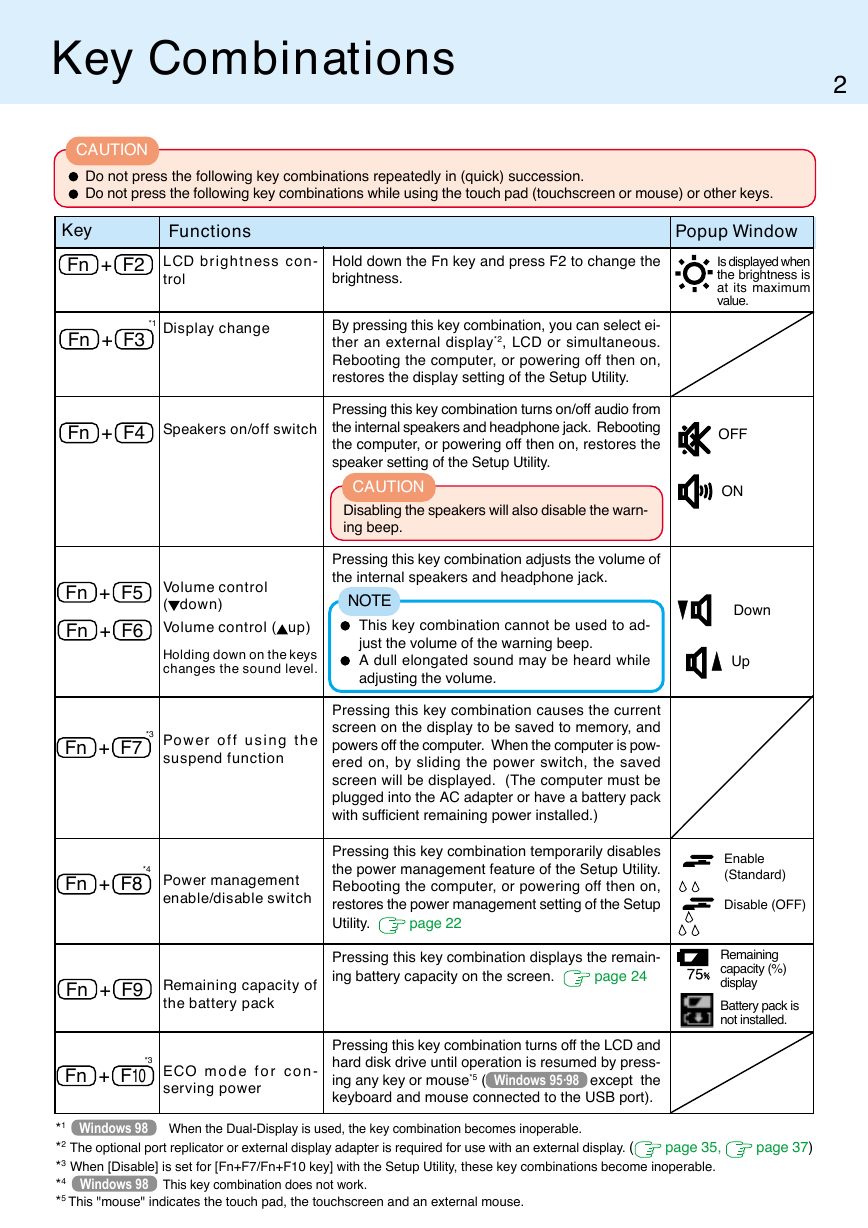
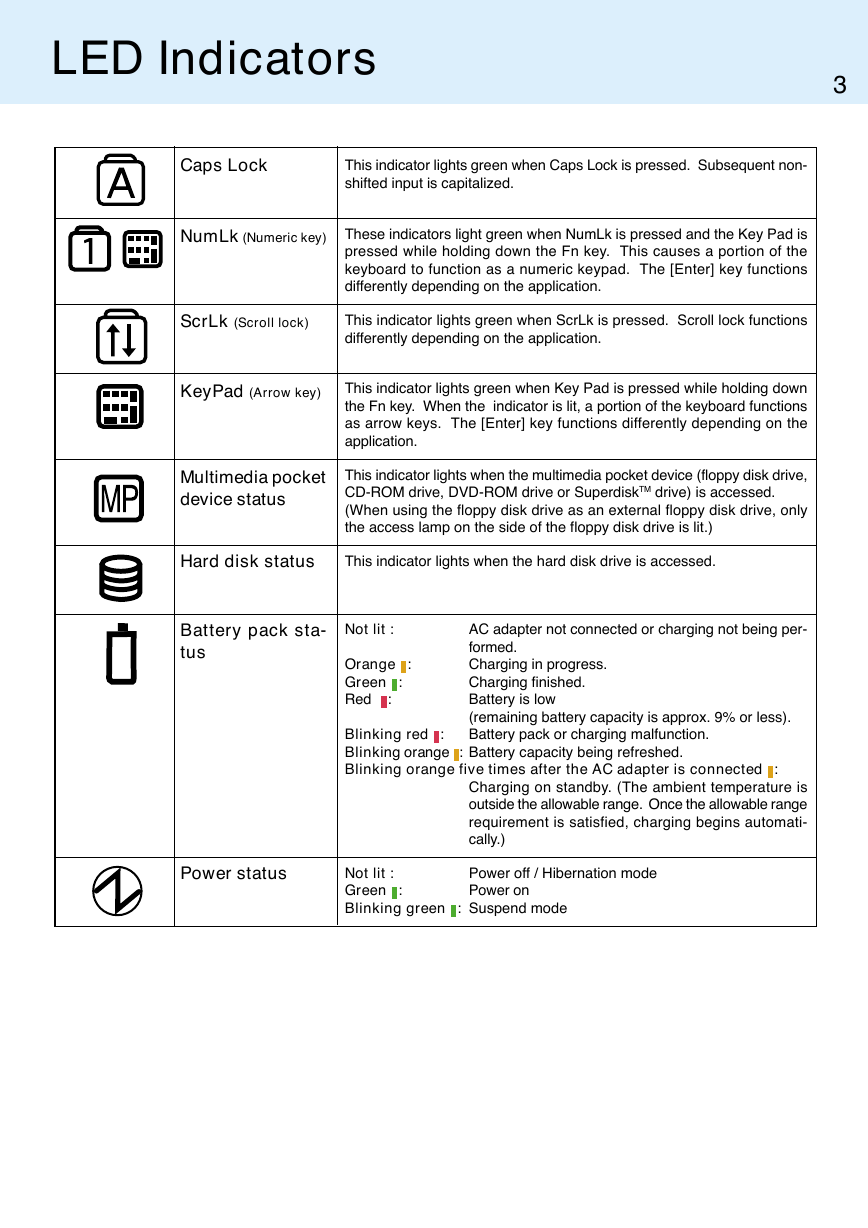
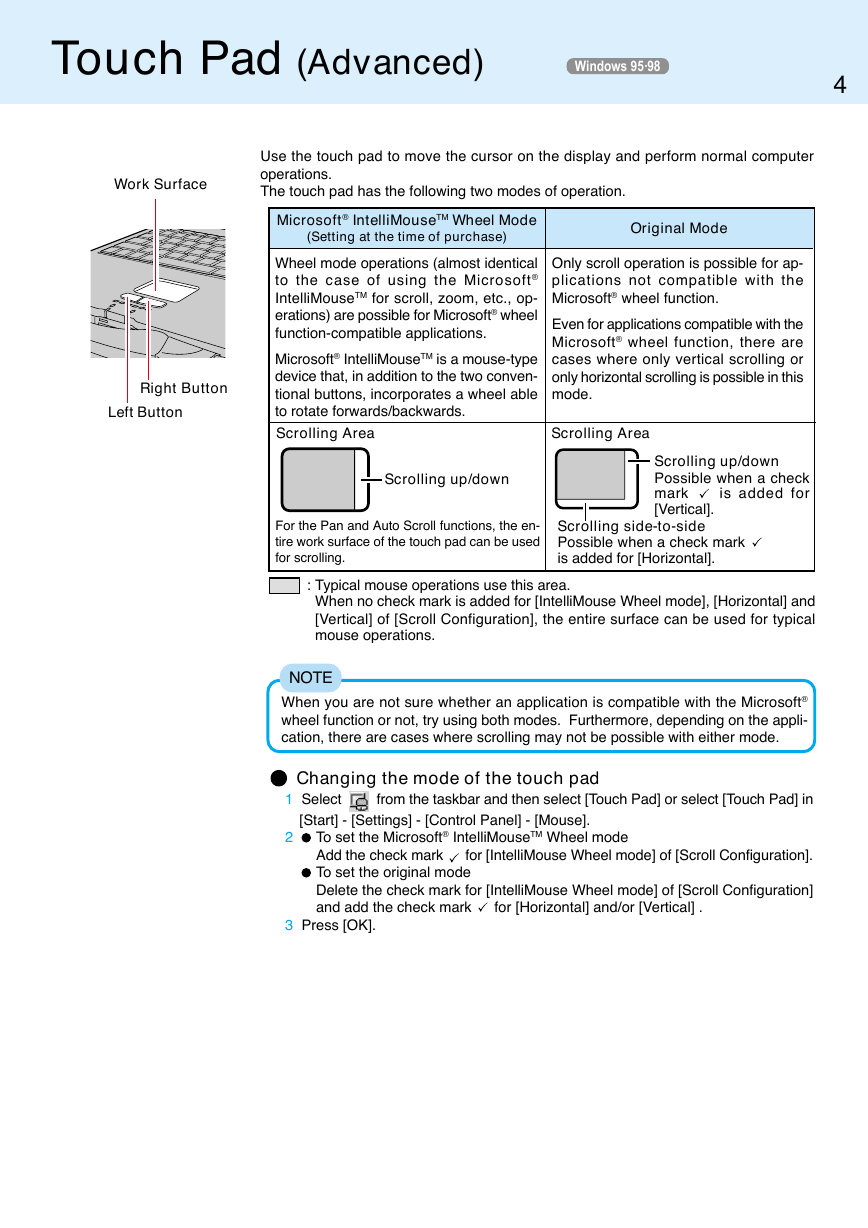
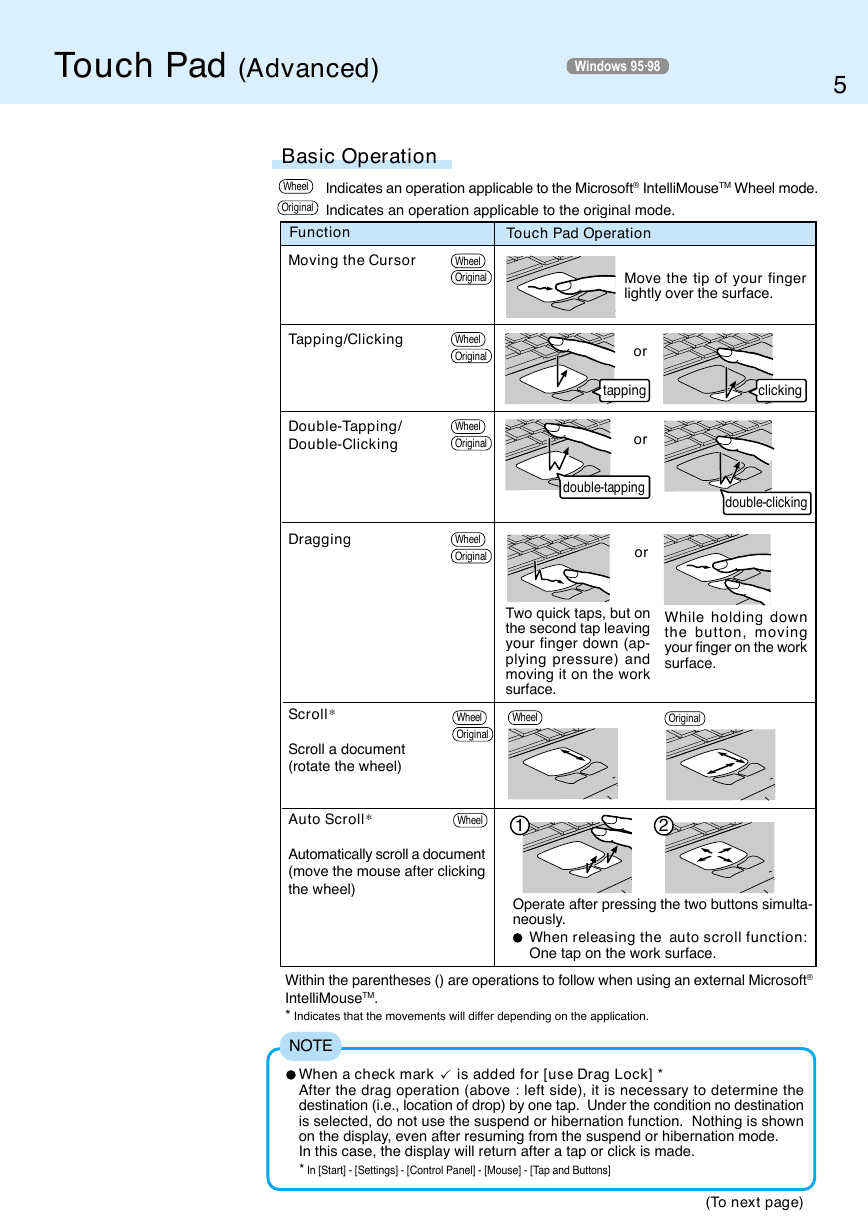
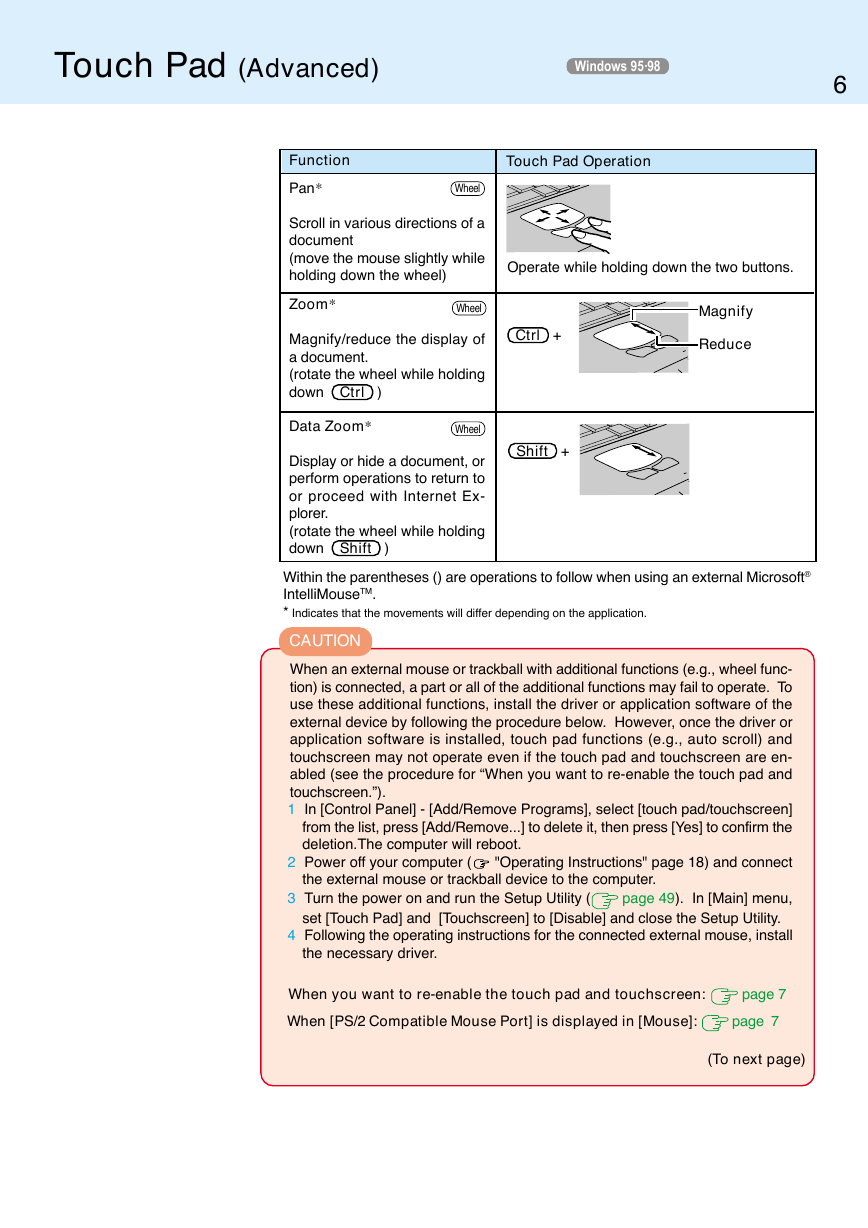
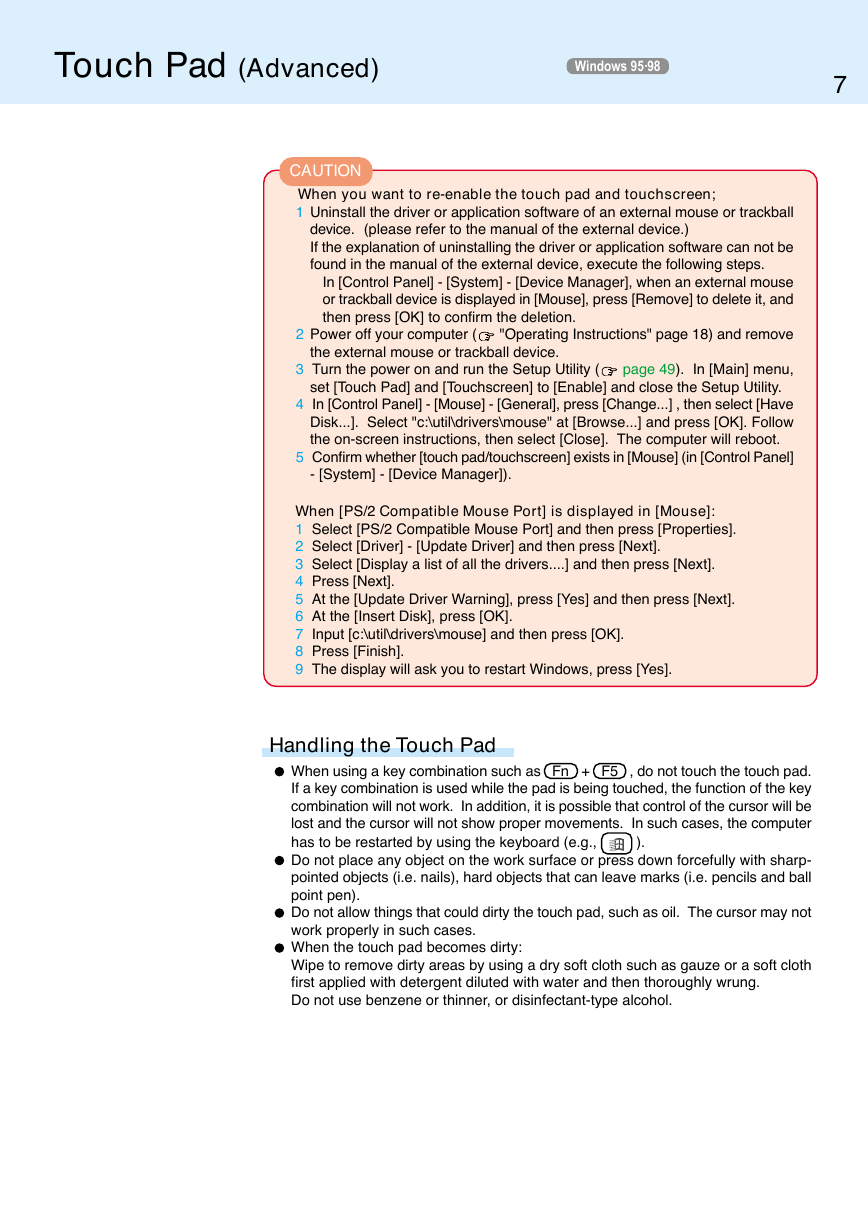
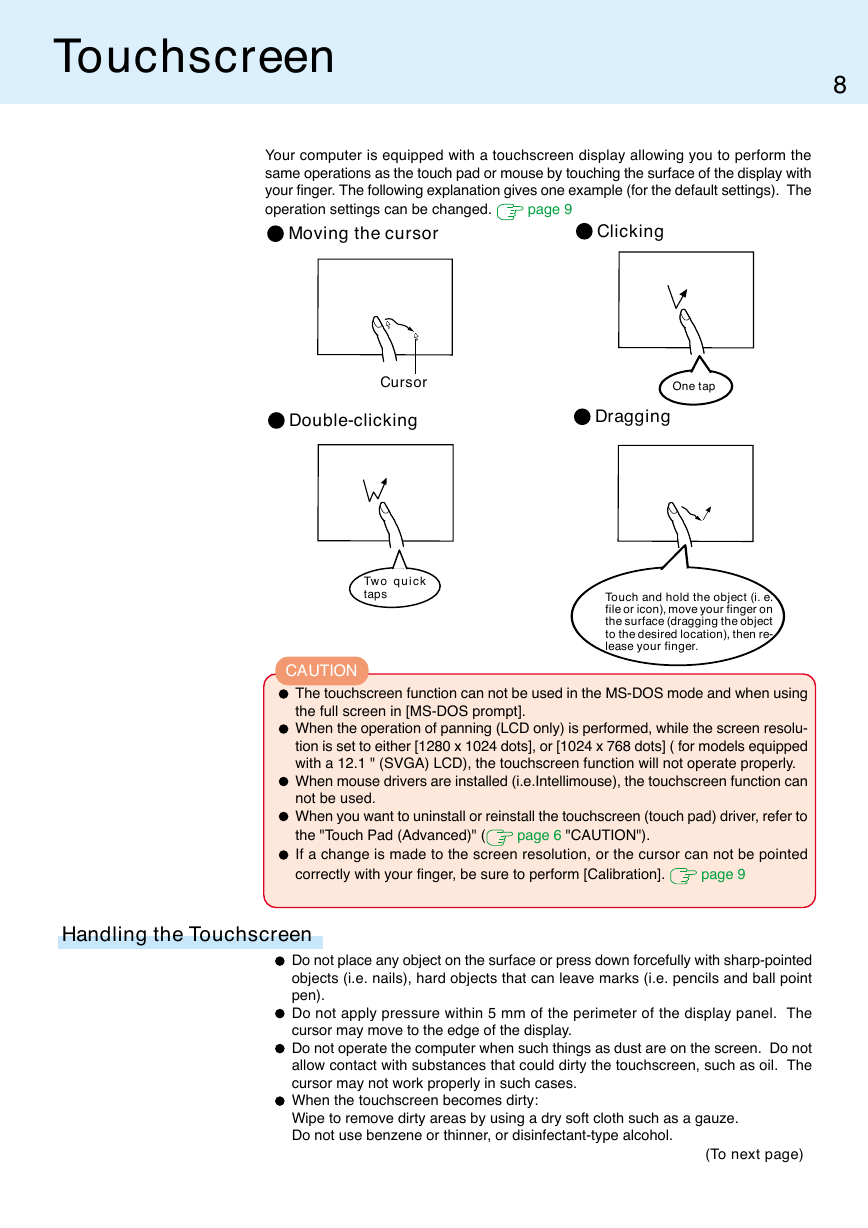








 2023年江西萍乡中考道德与法治真题及答案.doc
2023年江西萍乡中考道德与法治真题及答案.doc 2012年重庆南川中考生物真题及答案.doc
2012年重庆南川中考生物真题及答案.doc 2013年江西师范大学地理学综合及文艺理论基础考研真题.doc
2013年江西师范大学地理学综合及文艺理论基础考研真题.doc 2020年四川甘孜小升初语文真题及答案I卷.doc
2020年四川甘孜小升初语文真题及答案I卷.doc 2020年注册岩土工程师专业基础考试真题及答案.doc
2020年注册岩土工程师专业基础考试真题及答案.doc 2023-2024学年福建省厦门市九年级上学期数学月考试题及答案.doc
2023-2024学年福建省厦门市九年级上学期数学月考试题及答案.doc 2021-2022学年辽宁省沈阳市大东区九年级上学期语文期末试题及答案.doc
2021-2022学年辽宁省沈阳市大东区九年级上学期语文期末试题及答案.doc 2022-2023学年北京东城区初三第一学期物理期末试卷及答案.doc
2022-2023学年北京东城区初三第一学期物理期末试卷及答案.doc 2018上半年江西教师资格初中地理学科知识与教学能力真题及答案.doc
2018上半年江西教师资格初中地理学科知识与教学能力真题及答案.doc 2012年河北国家公务员申论考试真题及答案-省级.doc
2012年河北国家公务员申论考试真题及答案-省级.doc 2020-2021学年江苏省扬州市江都区邵樊片九年级上学期数学第一次质量检测试题及答案.doc
2020-2021学年江苏省扬州市江都区邵樊片九年级上学期数学第一次质量检测试题及答案.doc 2022下半年黑龙江教师资格证中学综合素质真题及答案.doc
2022下半年黑龙江教师资格证中学综合素质真题及答案.doc